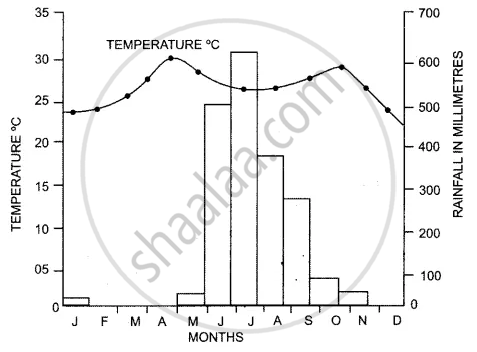Advertisements
Advertisements
प्रश्न
State the main factors that affect the climate of Indian sub-continent.
उत्तर
Its latitudinal extent, presence of the Himalayas, and presence of the Indian Ocean, Arabian Sea and Bay of Bengal in the south affect the climate of India.
APPEARS IN
संबंधित प्रश्न
Give reasons for the following:
The Northern Plains of India have a continental type of climate.
Explain giving any two reasons why the deltas of the river Mahanadi suffer from occasional floods.
Study the Temperature-Rainfall graph of station X below and answer the questions that follow :

(a) Is the location of station X Inland or coastal ? Give a reason for your answer.
(b) Which branch of the South West Monsoon brings, rain from the month of June to September?
Study the climatic data provided in the table below for a city A in India and answer the questions that follow :
| City | T/R | J | F | M | A | M | J | J | A | S | O | N | D |
| A | T | 20 | 23 | 26 | 32 | 35 | 39 | 34 | 28 | 25 | 28 | 24 | 21 |
| R | 14 | 23 | 27 | 42 | 121 | 231 | 300 | 306 | 289 | 160 | 34 | 5 |
T = Mean monthly temperature in degree Celsius (°C).
R = Average monthly rainfall in millimeters (mm).
(i) Mention two main features of the climate experienced by station A.
(ii) Calculate the annual rainfall for station A.
(i) What are the climatic conditions required for wheat cultivation in India?
(ii) Name the two main wheat-growing areas of China.
Answer the following question.
Mention the climatic conditions required for growing coconut in India.
The cold polar winds from Central Asia is prevented by the ______.
What are the three important factors which influence the mechanism of Indian weather?
What is the Inter-Tropical Convergence Zone?
Find out the temperature of Ooty (2240m) when it is 35°C in Chennai (6.7m)
